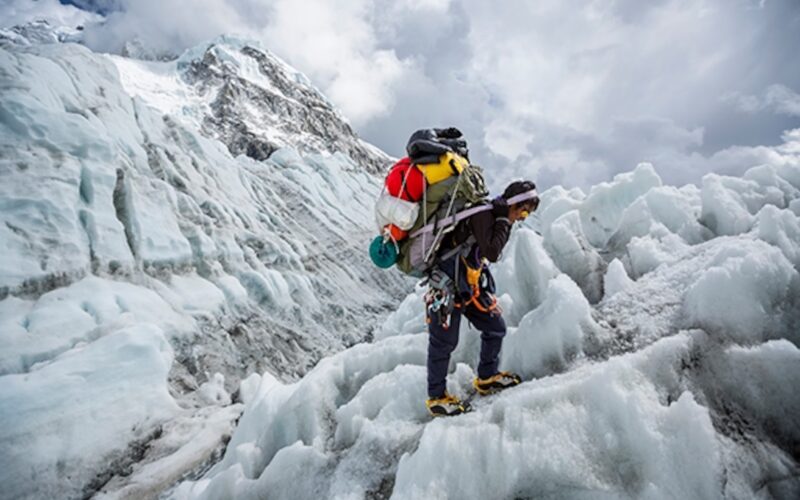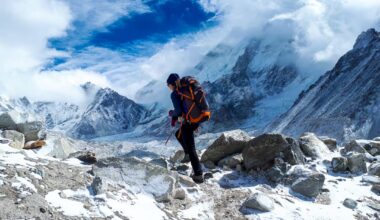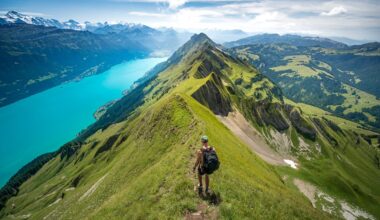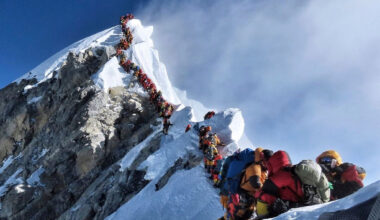The Khumbu Icefall is one of the most dangerous and awe-inspiring sections of the climb to Mount Everest. Located just above Everest Base Camp (5,364 m / 17,598 ft) on the Nepal side, this shifting maze of towering ice blocks, deep crevasses, and unstable seracs has earned its reputation as the most treacherous part of the world’s highest mountain.
In this blog, we’ll explore what the Khumbu Icefall is, why it’s so perilous, and what climbers must do to survive it.
What is the Khumbu Icefall?
The Khumbu Icefall is part of the Khumbu Glacier, the world’s highest glacier, stretching down from the Western Cwm to Base Camp.
- It moves at a rate of 0.9 – 1.2 metres per day, constantly reshaping itself.
- The ice towers (seracs) can be as tall as 12-storey buildings.
- Crevasses open and close unpredictably, making navigation incredibly risky.
This ever-moving, collapsing landscape explains why climbers often call the Icefall a “living, breathing beast.”
Why is the Khumbu Icefall So Dangerous?
The Khumbu Icefall has claimed many lives, even among the most skilled climbers and Sherpas. The key dangers include:
- Falling Seracs – Ice towers collapse without warning, crushing everything in their path.
- Avalanches – Surrounding peaks like Nuptse and Everest can unleash deadly avalanches into the Icefall.
- Crevasses – Hidden cracks can swallow climbers whole if not carefully navigated with ladders and ropes.
- Thin Air – At nearly 6,000 m, oxygen is scarce, slowing reaction times and increasing fatigue.
This is why climbers attempt the Icefall before sunrise, when the cold temperatures make the ice more stable.
How Do Climbers Cross the Khumbu Icefall?
Crossing the Icefall requires technical skills, bravery, and the work of dedicated Sherpa teams:
- Icefall Doctors – A team of Sherpas who fix ropes, ladders, and safety lines every season to make passage possible.
- Aluminium Ladders – Placed horizontally across crevasses or vertically on ice walls. Climbers walk across them with crampons, balancing above bottomless voids.
- Jumar & Ropes – Ascenders and fixed ropes provide security in case of slips.
- Pre-Dawn Climbs – Teams start at 2–3 AM to minimise exposure to collapsing ice.
Despite these precautions, no climb through the Khumbu Icefall is ever 100% safe.
Famous Tragedies in the Khumbu Icefall
The Icefall has witnessed multiple disasters:
- 2014 Avalanche – A massive serac collapse killed 16 Sherpas, marking one of the deadliest days in Everest history.
- 1996 Disaster – While most fatalities occurred higher on the mountain, the Icefall hindered rescue efforts.
- Annual Losses – Almost every climbing season reports accidents or near-misses in this section.
Tips for Surviving the Khumbu Icefall
While only professional climbers and Sherpas venture into the Icefall, here are the strategies used:
- Acclimatise Properly – Spend enough days at Base Camp before attempting.
- Follow Sherpa Guidance – Never attempt to cross without experienced Icefall Doctors.
- Go Light & Fast – Reduce time spent in the Icefall to limit exposure.
- Timing is Everything – Cross before sunrise when temperatures are coldest.
- Respect the Risk – Many experienced climbers say: “The summit is optional, but survival is mandatory.”
Why the Khumbu Icefall Still Attracts Climbers
Despite its dangers, the Khumbu Icefall remains a powerful symbol of the Everest challenge. To many, conquering it is the first true test of courage on the journey to the summit. Without crossing this deadly labyrinth, reaching the top of the world would be impossible.
Final Thoughts
The Khumbu Icefall is both beautiful and deadly—a shifting frozen river that guards the path to Everest’s summit. For climbers, it’s not just a physical obstacle but a mental trial that demands respect, courage, and absolute focus.
If you ever dream of standing atop Mount Everest, remember: the climb truly begins with the Khumbu Icefall.






